Spiders in the genus Loxoceles belong to a unique family known as the six-eyed sicariid spiders. These spiders all have 6 eyes (rather than the normal 8) that are arranged in a horseshoe pattern in 3 clusters of 2 eyes each. The family not only contains the genus Loxoceles, but also the six-eye crab spiders (genus Sicarius) of Central and South America and South Africa. This is the first group of spiders that were discovered to cause the condition known as necrotic arachnidism. This term refers to the main symptom caused by a bite of these spiders, namely rotting of the flesh. A physician in 1872 associated this symptom with the bite of the Chilean recluse spider. Up to that point the condition was referred to as gangrenous spot. In the US it wasn’t until 1957 that necrotic arachnidism was associated with the bite of the brown recluse spider.
Click here for some closeups of a Brown Recluse from Kevin Wiener.
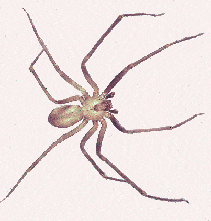
The young spiders then moult to the second stage and begin feeding. As the young spiders grow, they construct a loosely woven web and capture progressively larger prey. Male spiders moult 3 to 6 times before maturing. The females moult 6 to 8 times and occasionally eat the males after mating. Generally, the females are not aggressive unless agitated, although they are prone to bite when guarding an egg sac.
The Brown Recluse spider (Loxosceles reclusa) is a member of the “brown” spider family, Loxoscelidae. These spiders are also commonly referred to as “fiddleback” spiders or “violin” spiders because of the violin-shaped marking on the top surface of the cephalothorax (fused head and thorax). However, this feature can be very faint depending on the species of recluse spider, particularly those in the southwestern U.S., or how recently the spider has moulted.
The common name, brown recluse spider, pertains to only one species, Loxosceles reclusa.
The name refers to its colour and habits. It is a reclusive creature that seeks and prefers seclusion. They are light in colour and about 7mm long; their six eyes are arranged in two curved rows. They are most common in the western and southern United States. A few species are harmful to man – including the brown recluse, which occurs in the United States and Chile.
Table of Contents
Life Cycle:
Egg laying primarily occurs from May through July. The female lays about 50 eggs that are encased in an off-white silken sac that is about 2/3-inch diameter. Each female may produce several egg sacs over a period of several months. Spiderlings emerge from the egg sac in about a month or less. Their development is slow and is influenced by weather conditions and food availability. It takes an average of one year to reach the adult stage from time of egg deposit. Adult brown recluse spiders often live about one to two years. They can survive long periods of time (about 6 months) without food or water.
Habitat:
The brown recluse spider spins a loose, irregular web of very sticky, off-white to grayish threads. This web serves as the spider’s daytime retreat, and it often is constructed in an undisturbed corner. This spider roams at night searching for insect prey. Recent research indicates that the brown recluse spider is largely a scavenger, preferring dead insects. Mature males also roam in search of females. Brown recluse spiders generally occupy dark, undisturbed sites, and they can occur indoors or outdoors. In favorable habitats, their populations are usually dense. They thrive in human-altered environments. Indoors, they may be found in attics, basements, crawl spaces, cellars, closets, and ductwork or registers. They may seek shelter in storage boxes, shoes, clothing, folded linens, and behind furniture. They also may be found in outbuildings such as barns, storage sheds, and garages. Outdoors, brown recluse spiders may be found underneath logs, loose stones in rock piles, and stacks of lumber. The brown recluse spider is not aggressive, and it normally bites only when crushed, handled or disturbed.
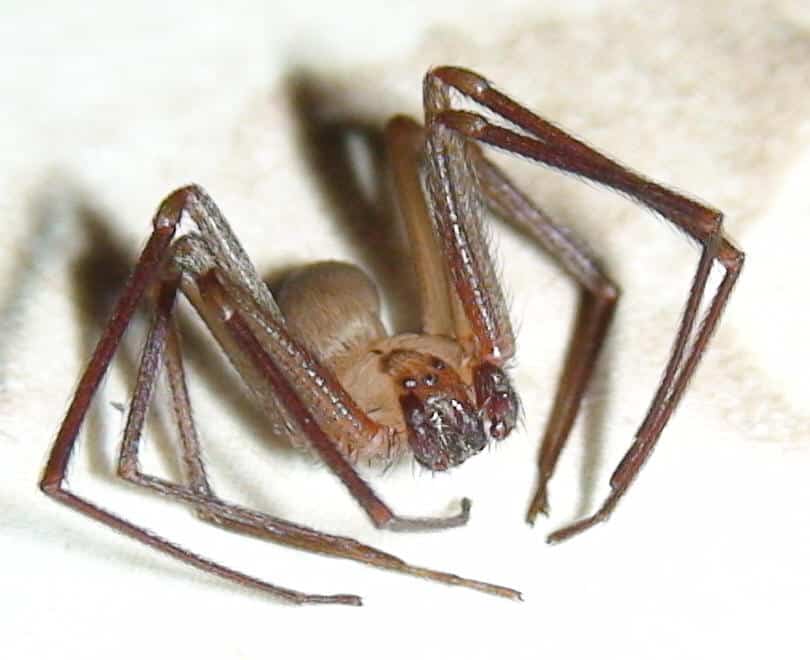
Some people have been bitten in bed after inadvertently rolling over onto the spider. Others have been bitten after accidentally touching the spider when cleaning storage areas. Some bites occur when people put on seldom used clothing or shoes inhabited by a brown recluse.
Bites:
The brown recluse spider is a shy species that bites humans when trapped in clothing or rolled onto when people sleep in bed. Persons bitten by the brown recluse usually do not feel pain for 2-3 hours. A sensitive person may feel pain immediately. A blister arises around the area of the bite. The local pain becomes intense with the wound sloughing tissue often down to the bone. Healing takes place slowly and may take 6 to 8 weeks. If the bite of a brown recluse spider is suspected, collect the spider and consult a physician immediately.
The venom of the brown recluse destroys the walls of the blood vessels near the site of the bite, sometimes causing a skin ulcer several inches in diameter. The wound, which may take several months to heal, is occasionally fatal. A brown recluse bite may go unnoticed for 6-8 hours, before a reddening, swelling and blistering of the wound starts to appear. The occurrence of additional symptoms of a recluse bite will depend upon the amount of venom injected by the spider. A severe bite can produce a necrotic lesion (i.e., an area of dead skin tissue) that may require surgery. Although an antidote has been developed, it is not widely available and it appears to be most effective before the lesion develops. In some cases, antibiotics and the drug Dapsone may be used successfully to treat the bites without surgery, but these decisions are made after careful diagnosis by a physician. Prompt medical attention is critical to successful chemical or surgical treatment of the bite.
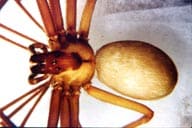
Other types of Recluse spiders
Loxoceles laeta
Loxoceles laeta, know as the Chilean brown spider, also prefers tight places in buildings. The bite of this spider is partially systemic and sometimes fatal. Internal bleeding often affects the kidneys and liver. Unfortunately, 50% of children bitten in South America die without treatment. Antivenin is available in South America. The bite’s progress is slightly different from the recluse in that the ulcerated area is dark rather than white. This spider is a nocturnal hunting spider that searches for prey away from its web.
The Desert Recluse Spider (Loxoceles deserta)
The Desert Recluse Spider (Loxoceles deserta) is another relative of the more notorious brown recluse, or violin spider. The distribution of this species in California is quite limited, occurring in isolated desert areas above 3,000 feet elevation.
This is a medium sized non-descript tan species with many fine hairs covering the body. Very few people are bitten by this species and the symptoms are similar to, but far less severe than, that of its cousins.
Very little is known about the bite or symptoms of the other recluse spiders that are found in the United States.
Other Recluse Spiders around the world
- The Tucson recluse, Loxoceles Sabina. Limited to Tuscon area.
- The Arizona recluse, Loxoceles arizonica. Central and southern Arizona and SE California. The Baja recluse, Loxoceles palma. Baja and S.California.
- The Big Bend recluse, Loxoceles blanchi. Western Texas.
- The Grand Canyon recluse, Loxoceles kaiba. Grand Canyon.
- Matha’s recluse, Loxoceles martha.
- The Mediterranean recluse, Loxoceles rufescens. Introduced species, several US cities. Bite not considered as toxic as some of the other species.
Russell’s recluse, Loxoceles russelli. Death Valley.
The Texas recluse, Loxoceles devia. Texas.
The Tucson recluse, Loxoceles sabina. Tucson area.
Often the Brown Recluse and male Southern House spider are confused. The photos below show a close up of the eyes of both which are quite clearly different. However its often hard to tell when they are scurrying across your floor at night!!
Brown Recluse Spider is on the left and male Southern House Spider is on the right.
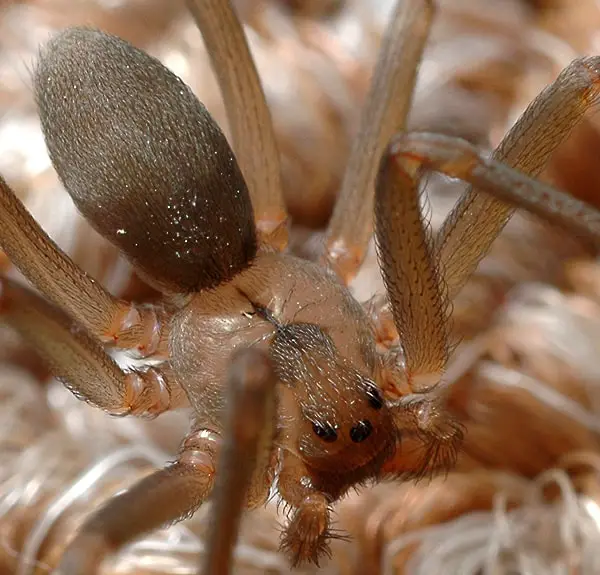
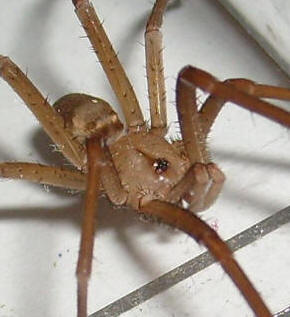
Click here for more photos of Recluse spiders.
Information and pictures were taken from children’s projects and where credited to that child does not claim to be original information. Where possible, permission to reproduce has been sought. Any infringement of copyright is purely unintentional.
